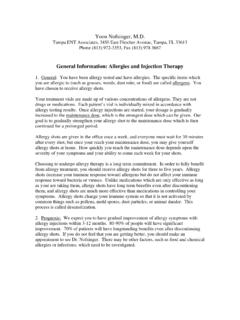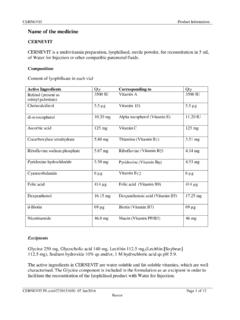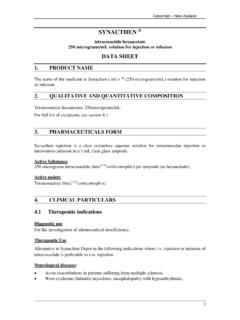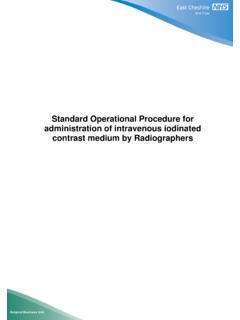Transcription of Data Sheet FERRUM H INJECTION - Medsafe Home …
1 data Sheet FERRUM H INJECTION Iron polymaltose compound PRESENTATION A slightly viscous, dark reddish brown liquid. Odour faintly malt-like. Each ampoule of FERRUM H contains the equivalent of 100 mg of iron. USES Actions FERRUM H is complexed in an aqueous, approximately isotonic solution for intramuscular INJECTION . The complex is stable over a wide pH range (1-14) and each ampoule contains the equivalent of 50 mg iron per mL. Pharmacological tests have shown that the complex has a LD50 (intravenous) of >2500 mg iron per kg in white mice.
2 Pharmacokinetics After an infusion of 100 mg iron as FERRUM H in 48 mL sodium chloride, at a rate of mL/min, a Cmax (in serum) of mcg/mL iron was observed. The terminal half-life was hours. The MRT hours and the VD (distribution volume) litres. Renal elimination is less than 1% of the total dosage. Iron polymaltose shows a high structural homogeneity and thus steady delivery of the complexed iron to endogenous iron binding proteins. Taken up from plasma by the reticuloendothelial system (RES), the iron is split off, binds to transferrin and partially re-enters the plasma from where it reaches the bone marrow for haemoglobin synthesis.
3 INDICATIONS For the prevention and treatment of iron deficiency anaemia in the following circumstances: When oral therapy is contraindicated When enteric absorption of iron is defective When patient non-compliance or persistent gastrointestinal intolerance makes oral therapy impractical Treating iron deficiency anaemia of prematurity and that occurring in geriatric patients Treating iron deficiency states discovered in the third trimester of pregnancy Anaemia resulting from excessive blood loss Where contact between the doctor and patient occurs at irregular intervals DOSAGE AND ADMINISTRATION Intramuscular Use
4 Technique of INJECTION The technique of INJECTION is of crucial importance. FERRUM H should never be injected into the arm or other exposed areas. The wrong INJECTION technique may result in pain and persistent discolouration of the skin. The following method of ventro-gluteal INJECTION according to HOCHSTETTER is recommended instead of the normal method of INJECTION in the top outer quadrant of the gluteus maximus muscle: 1. The length of the needle should be at least 5-6 cm. The lumen of the needle should not be too wide. 2. The site of INJECTION is determined as follows (see Fig.)
5 1): First point A is found, corresponding to the ventral iliac spine. If the patient lies on the right side, for instance, the middle finger of the left hand is placed on point A. The index finger is extended away from the middle finger, so that it comes to lie below the iliac crest, at point B. The triangle lying between the proximal phalanges of the middle and index fingers represents the site of INJECTION . This is disinfected in the usual way (Fig. 2). 3. Before the needle is inserted, the skin over the site of INJECTION is pulled down, about 2 cm (Fig.
6 3), to give an S-shaped puncture channel. This prevents the injected solution from running back into the subcutaneous tissues and discolouring the skin. 4. The needle is introduced more or less vertically to the skin surface, angled to point towards the iliac crest rather than the hip joint (Fig. 4). 5. After the INJECTION , the needle is slowly withdrawn and pressure from a finger applied beside the puncture site. This pressure is maintained for about one minute. 6. The patient should move about after the INJECTION . Calculation of Required Dose The figures in the accompanying dosage table have been calculated using the following formula taken from GANZONI (Schweiz.
7 Med. Wschr. 100, 301-303, 1970): Iron dose (mg) = Hb-iron deficiency + iron depot Hb-iron deficiency = body weight (kg) x (target Hb actual Hb in g/L) x * * factor = x x 1000 (for the purposes of this calculation, iron content of the haemoglobin = , blood volume = 7% of the body weight, 1000 is the conversion from grams to milligrams). Note: The above formula can also be used to calculate the total iron deficit. Up to 34 kg body weight: target Hb = 130 g/L, iron depot = 15 mg/kg body weight (for a patient weighing 34 kg the iron depot is 34 x 15 = 500 mg).
8 Over 34 kg body weight: target Hb = 150 g/L, iron depot = 500 mg. Example of Calculation Assuming patient weighing 60 kg, target Hb 150g/L, actual Hb 60g/L then: Iron dose (mg) = 60 x (150-60) x + 500mg= 1296 mg + 500 mg = 1800 mg iron Therefore patient requires 1800 mg iron or 18 ampoules. Dosage Table Dosage table for the determination of the total millilitres of FERRUM H INJECTION required. Body weight kg Hb 60 g/L Hb 75 g/L Hb 90 g/L Hb 105 g/L mL amp. mL amp. mL amp. mL amp. 5 3 3 3 2 1 10 6 3 6 3 5 4 2 15 10 5 9 7 6 3 20 13 11 10 5 8 4 25 16 8 14 7 12 6 11 30 19 17 15 13 35 25 23 20 10 18 9 40 27 24 12 22 11 19 45 30 15 26 13 23 20 10 50 32 16 28 14 24 12 21 55 34 17 30 15 26 13 22 11 60 36 18 32 16 27 23 65 38 19 33 29 24 12 70 40 20 35 30 15 25 75 42 21 37 32 16 26 13 80 45 39 33 27 85 47 41 34 17 28 14 90 49 43 36 18 29 Administer 2 mL by intramuscular INJECTION every second day until the total dose is attained or administer 4 mL
9 At longer intervals. Regular determination of Hb level is recommended. Maximum Single Daily Dose by Intramuscular INJECTION Infants up to 5 kg body weight: mL Children of 5-10 kg body weight: 1 mL Patients weighing > 10 kg to 45 kg: 2 mL Adults: 4 mL CONTRAINDICATIONS FERRUM H should not be given to patients presenting with any of the following conditions: Hypersensitivity to iron(III) hydroxide polymaltose complex Anaemia not caused by simple iron deficiency ( haemolytic anaemia, megablastic anaemia caused by Vitamin B12 deficiency, disturbances in erythropoesis, hypoplasia of the marrow) Iron overload ( haemochromatosis, haemosiderosis)
10 Ostler-Rendu-Weber syndrome Chronic polyarthritis Bronchial asthma Infectious renal complaints in acute phase Uncontrolled hyperparathyroidism Decompensated hepatic cirrhosis Infectious hepatitis During the first trimester of pregnancy As elemental iron tends to accumulate in inflamed tissues, parenteral iron should not be given to patients with severe inflammation or infection of the kidney or liver. WARNINGS AND PRECAUTIONS Since parenteral use of complexes of iron and carbohydrates has resulted in fatal anaphylactoid reactions, iron polymaltose should be used only in patients in whom a clearly established indication for parenteral iron therapy exists, confirmed by appropriate laboratory tests.















